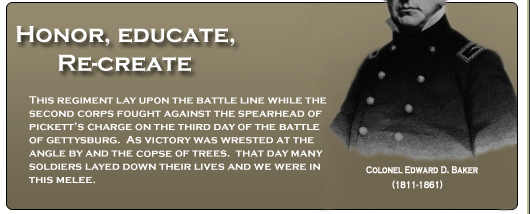|
History
Recruiting for the Seventy-first, originally known as the California Regiment, was commenced in Philadelphia in the early part of April, 1861, under the direction of Edward D. Baker, United States Senator from Oregon, who had been especially commissioned by President Lincoln for the purpose. The business was under the immediate charge of Isaac J. Wistar of Philadelphia, who had been a trapper in the Hudson Bay Company, had commanded Indian Rangers in Oregon and California in 1850-51, and was inured to wild warfare in the early settlement of the Pacific coast. In one month's time eleven hundred men were enlisted, and were sent by squads and companies to report to the headquarters of the regiment established in New York, subsequently at Fort Schuyler, near the city, where it was mustered into service and organized by the choice of the following field officers:
- Edward D. Baker, Colonel
- Isaac J. Wistar, Lieutenant Colonel
- R. A. Parrish, Major
Not having been recognized by either Pennsylvania or New York, it was treated as belonging to the regular army, and its returns were made accordingly. Here it remained engaged in drill and discipline until the 1st of July, when it proceeded to Fortress Monroe via Philadelphia, parading in the latter city, to the great credit of its officers and the satisfaction of its friends.
Upon its arrival at the Fortress it was assigned to arduous picket and scouting duty, and rendered important service in obtaining valuable information of the movements of the enemy while in the vicinity of Big Bethel.
The regiment remained at Fortress Monroe until after the first battle of Bull Run, when it was ordered to the south bank of the Potomac, opposite the city of Washington, where it was engaged in building earth-works, and in guarding the line of fortifications which encircled the capital.
On the 11th of September, while out upon a reconnoissance, it was attacked by a large body of the enemy, consisting of infantry, cavalry, and artillery. This was the first time that it was under any considerable fire, and the spirit and steadiness displayed gave ample proof of the excellent material of which it was composed, of the discipline attained, and of the confidence reposed by the rank and file in its officers. Picketing and scouting were now of daily occurrence, and from the similarity of its uniform, gray, to that of the rebels, the duty was extremely hazardous, the men being frequently mistaken for the enemy. Among the killed while on this service was Captain James W. Lingenfelter of company B, killed while on the picket line. He was a useful officer and had come from the Pacific coast to serve with Colonel Baker.
On the 29th of September the regiment participated in the general advance on Munson's Hill, then occupied by the enemy. In the march, it held the right of the division commanded by General W. F. Smith, its right battalion, commanded by Lieutenant Colonel Wistar, in the absence of Colonel Baker, leading the column. Two sections of artillery followed, then the left battalion, and the balance of the division. Companies A and D, under command of Captain Markoe, were thrown out as skirmishers. The night was dark, and the road a narrow track through dense forest. Erroneous information had been received by the general in command respecting the pickets of the division on the left. The result was a collision, by which four men were killed and fourteen wounded, several of them mortally. Order was at length restored and the advance resumed.
Source:
Bates, Samuel P. History of the Pennsylvania Volunteers, 1861-65, Harrisburg, 1868-1871.
|









